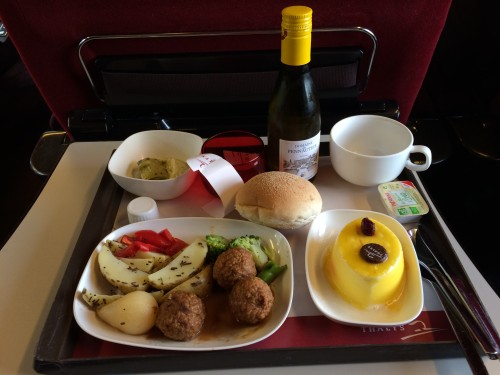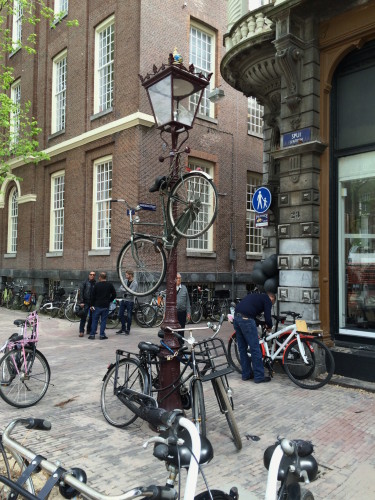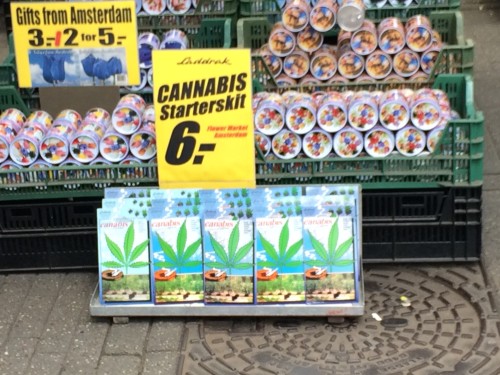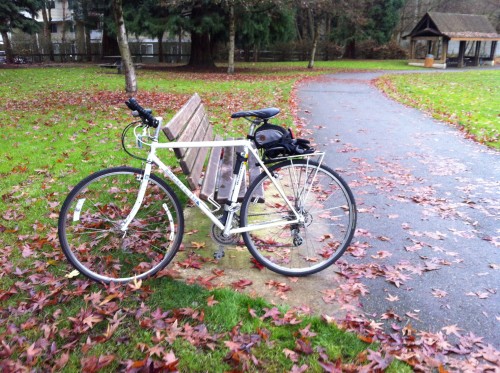We arrived in Paris in the early afternoon. We applied several lessons learned from our previous trip here four years ago:
- Always buy Métro tickets from a human being rather than a machine;
- Ignore any solicitations; and
- Build up your upper body strength before the trip so you can haul your suitcases upstairs. The French don’t have an equivalent of the Americans with Disabilities Act. (Elevators in a Métro station, if they exist, are well-hidden.)
Our rental apartment is just outside a Métro station near the old Les Halles market. Rue Montorgueil, a major foodie street, is only two blocks away. Despite its central location, it’s reasonably quiet–at night. This morning was pretty cacophonous, since it’s a back to work day. We chose the courtyard-facing bedroom. Our traveling companion for this leg of the trip is our friend Roger from Nyack (NY). He arrived from Reykjavik before we did.

View from our flat.
We had dinner on our first night at Comptoir de la Gastronomie, a gourmet shop/restaurant on Rue Montmartre. Julian and I started out with asparagus gazpacho, while Roger had mackerel mousse with cucumber and aspic. For the main dish, the guys had two huge mounds of pork ribs. I was in need of vegetables, so I had pasta with a mixture of fava beans, fennel, tomato, mushrooms, and zucchini. A fine repast was had by all.
Permanent link to this article: http://ediblethoughts.com/2015/05/26/ah-paris/
You don’t see as many bikes on main streets in Paris as you do in Amsterdam. There’s a simple reason: The drivers are maniacs! Nobody wants to be somebody’s hood ornament. Cyclists tend to stick to side streets where they have a better chance of survival.
Permanent link to this article: http://ediblethoughts.com/2015/05/26/the-paris-bike-culture/
We hopped a Thalys high-speed train from Amsterdam to Paris. Our seats were in a car with free Wi-Fi and food. Having flown cheapo US airlines for too long, I expected the usual peanuts or pretzels. Wrong! Shortly after we got on the train in Amsterdam, we had the choice of a savory or sweet snack. Both of us chose a small bite of vegetable quiche. We thought that was the end of it; however, when we left Brussels, the stewards came around again with lunch.

I could get used to this…
Lunch consisted of rabbit meatballs with potatoes, vegetables, a small poached pear, artichoke purée, a roll, and a cheesecake-like dessert with lemon glaze. The wine was complimentary. Sure beats peanuts.
Permanent link to this article: http://ediblethoughts.com/2015/05/25/onward-to-paris/
Amsterdam has a reputation as a pretty freewheeling city, between the cannabis and red-light district. Here’s another example, a poster we saw on our way to the train station.

Permanent link to this article: http://ediblethoughts.com/2015/05/25/no-comment-necessary/
We spent two days in Amsterdam, commuting by train from Kitty’s home in Zaandam. Amsterdam is very easy to get around, thanks to the transit system and the layout around the canals. There was a huge influx of visitors due to the Whitsuntide (Pentecost) holidays. Although many stores are closed on Sundays, a large number catering to tourists were wide open for business. Commerce triumphs over all.
On our first day we just wandered hither and yon through neighborhoods. By chance we found a number of used booksellers in a neighborhood called the Spui (pronounced Spwee). We also visited the Begijnhof (hard to spell phonetically), which used to be a home for pious Catholic women who opted not to take the vows of nuns. It’s still being used as a home for single middle-aged women, regardless of their religions. There are Protestant and Catholic chapels in the Begijnhof. We chatted with the docent of the Protestant church, a woman from Kentucky who immigrated here when she married a Dutch man.
On the second day we had specific missions. Our first stop was the Dutch Resistance Museum, across the street from the Zoo. The history of how the Dutch fought back against the Nazis was truly amazing. (By coincidence, the Washington Post ran a story on Memorial Day of a small town in southern Holland where families volunteer to care for the graves of American soldiers who died liberating the country. Descendents of the soldiers have formed bonds with volunteers and other members of the town.) Our next stop was the Jordaan, a picturesque residential neighborhood. Some of the old homes had been torn down for modern monstrosities until the city wised up and changed its zoning rules. The cafés and coffee shops were doing great business. (See my earlier post for a distinction between the two.) Julian took plenty of pictures of the local architecture.
At the end of the day Julian asked me if I might be interested in retiring in Holland. First, I’m too young to retire. Second, their housing prices are even more exorbitant than Seattle’s. Third, I’d have to learn to speak Dutch. Dealing with German was hard enough for me four years ago when we visited Berlin and Switzerland. Fortunately, English is the unofficial second language in the Netherlands. Even the panhandlers in Amsterdam speak impeccable English!
Permanent link to this article: http://ediblethoughts.com/2015/05/25/amsterdam-impressions/
We visited the Amsterdam area for the first time in over 20 years. We stayed with Julian’s cousin, Kitty. She lives on a river in Zaandam, a suburb of Amsterdam. You can see a series of latter-day (electricity-generating) windmills from the windows of her condo. Not quite as picturesque as the original ones, but they serve similar purposes.

A quaint windmill over the harbor in Zaandam.
On our first day, we took a road trip to two of the older towns in the area. The first was Edam (home of the cheese). As with most Dutch towns, Edam is crisscrossed by canals. We visited a small 17th century Protestant church and walked around the downtown area. The second town was Enkhuizen. (Don’t ask me to pronounce this!) This town fronts the IJsselmeer (this is not a misspelling, and I won’t try to pronounce this), a large body of water created by a dam across the Zuider Zee. We had a late lunch in Enkhuizen. I watched the café’s corpulent canine chase bikes on the walk outside while we were eating. A very Dutch scene.
On Saturday we went to Delft for a 150th birthday party. The sum of Kitty’s daughter’s family’s ages is 150. It was quite a crowd in the basement of a tavern. Kitty’s youngest granddaughter, age 10, was helping to tend bar. (In the States, Child Protective Services would take the children away if they were notified of a similar situation.) She did a fantastic job. The best part of the party was meeting some of Julian’s relatives that he’d never met. As most of his US relatives are no longer living, it’s good to know he has family somewhere.
Permanent link to this article: http://ediblethoughts.com/2015/05/25/first-stop-netherlands/
Seattle’s bike culture has nothing on the Netherlands. Bikes are a main transportation option, and not just for the Spandex warriors. Most of the bikes resemble 1960’s-vintage Schwinns–single speed, covered chains, heavy frames, upright handlebars, fenders, and kickstands.

Hey, you have to park somewhere.
Many are customized to carry cargo and/or kids. Most of the bikes are step-through, and it’s not considered girly for a man to ride one of these bikes. Riders, even children, rarely wear helmets. The main plazas of Amsterdam are packed with bikes and bike racks. In addition, there are bike parking lots on barges around the city. This is a bike-parking garage adjacent to the Central Train Station.

Bike parking garage in Paris.
The problem is the lack of enforcement of traffic laws for bicyclists. In theory, they are supposed to follow the same rules of the road as cars; in practice, it’s pedestrian beware. We were nearly clipped or run down more than once by bikers. It was nearly as bad as the Burke-Gilman Trail in Seattle during prime training season for the Seattle-to-Portland bike race. Who knew these old-school schleppers could move so fast?
Permanent link to this article: http://ediblethoughts.com/2015/05/25/the-bike-cult-in-holland/
I know what some of you are thinking: “Dude, you visited Amsterdam…” Yes, we did. (I’ve had more traffic from that one post on the Seattle pot shop than anything else. What does this say about web surfers these days?) Here is a product we saw at the Flower Market. Imagine the US Customs officer finding this in your suitcase.

Kids, don’t try this at home.
Amsterdammers call cannabis outlets “coffee shops”, whereas cafés are stores where you consume only food, coffee, or tea. Sometimes coffee shops and cafés are next door to each other, which undoubtedly magnifies the confusion for elderly tourists from Sheboygan or Saskatoon.
I’ll answer your next question before you ask it: No, we didn’t go into a coffee shop. Truth be known, it’s not necessary to enter a coffee shop and purchase product to get a buzz. All you have to do is stand on the sidewalk outside the entrance and inhale. We saw plenty of twentysomethings from Sheboygan, Saskatoon, Strasbourg, and Siena going in them, however. One tour group, which seemed to be focused on Amsterdam’s “alternative cultures”, parked itself prominently in front of a coffee shop. The guide told the tourists they could go inside if they wished. Was the coffee shop giving the tour guide a commission??? Did he do the same in the Red Light District???
Permanent link to this article: http://ediblethoughts.com/2015/05/25/the-amsterdam-coffee-shop-culture/

Lafayette, here we come!
Later this week Julian and I leave for Europe for a long-overdue vacation. We first land in Amsterdam to visit his cousins. We then take a train to Paris for a week in a rented apartment. Our friend Roger will be joining us, which means much silliness will ensue. We’ll rent a car and hightail it to the southwestern part of France, so we can visit tiny medieval towns en route to our final two days in Lyon.
Preparations for this trip were only slightly less complicated than the D-Day invasion. We (rather, Julian) booked our plane and train tickets and reserved hotel rooms months in advance. We have two catsitters lined up, as one will be out of town Memorial Day weekend.We had a scare last week when we hadn’t heard from the apartment owner to arrange the key handoff. Luckily, that got reconciled. One of the last loose ends was getting transportation to the airport. Our current home is off the beaten path for most taxis and shuttles. We finally found a driver who will take us to and from the airport for less than the usual limo service.
Expect periodic posts from us, with photos and commentary on food, current events, and general hilarity.
Permanent link to this article: http://ediblethoughts.com/2015/05/17/edible-thoughts-goes-on-the-road/

Taking five from the trail.
May 15 was Bike to Work Day in the Seattle area. The weather was ideal–cool in the morning, with a high in the mid 60’s. I rode to a nearby park and ride, caught the bus to the main hospital, and then rode to the satellite hospital where I work. Assorted organizations set up rest and swag stations around town. My officemate, who rode to work from West Seattle, stopped at so many stations his pack was getting heavy from all the goodies he picked up. The station at my hospital offered free bike tune-ups. I took the opportunity to get my front derailleur degrunged and adjusted.
I did, however, ride all the way home. It’s a 16-mile trip, but a good portion of it is downhill. An early highlight is Interlaken Park, an old-growth forest surrounded by a residential area. The road switchbacks down a steep hill. Fortunately, the traffic is pretty low on that road even during rush hours. Over half the ride is on the Burke-Gilman Trail. This former railroad right of way runs through the University of Washington campus and ends about a block from our home. It offers stellar views of Lake Washington and the Cascade Mountains to the east. Although the trail is heavily traveled, it’s rarely gridlocked–unless you have people riding two or three abreast.
The festivities continued for many on the commute home. There is a brewpub and beer garden in Kenmore across from the park and ride where I caught the bus, which is just off the Burke-Gilman. They had a serious party going on as I rode past, complete with a band. The tables in the beer garden were packed with Spandexed and helmeted revelers. Their bikes were locked up on any available fencing. I didn’t stop, since I was only a mile from home at that point. (It was also my night to cook, and it was nearly 6 pm.)
I’ll be commuting by bike more as the summer goes on; however, Edible Thoughts will be posting from Europe for the next couple of weeks. More to come.
Permanent link to this article: http://ediblethoughts.com/2015/05/16/bike-to-work-day/
Load more










Recent Comments